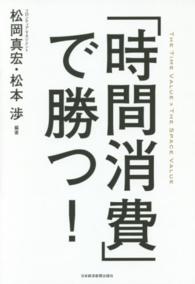Full Description
We both give meanings to, and derive our own meanings from, the multitude of objects we live amongst. Trivial things remind us of past loves; old things embody an idealized past; on other things we believe our fate depends. In this book, Karl-Heinz Kohl describes relationships to sacred objects from the viewpoint of anthropology and the history of religion, showing how people of all cultures ascribe quite immeasurable value to things and make their own destiny dependent on these objects.During their voyages of discovery, Portuguese seafarers came across Africans who attributed mysterious powers to objects that became known as 'fetishes', and the concept of 'fetishism' soon cast a spell over European thinkers. The Church condemned it as the work of the devil, while for the philosophers of the Enlightenment it proved that no religion was rational at heart. But the fascination remained - Hegel, Comte, Marx and Freud - each of them tried to solve the riddle of fetishism in their own way. And it is fetishism that is the starting point for this book, which offers nothing less than a comprehensive theory of the sacred object,from the stone cult of ancient Israel and the Bible's prohibition on images, to the medieval cult of reliquaries, Native American sacred bundles, magical figures of the BaKongo, and the idols of the Ancient Greeks. Tracing the fate of ancient cult images since their rediscovery in the Renaissance, Kohl comes to a striking conclusion: in the secularized societies of the Global North, it is the museum cult that is the bastion of contemporary fetishism.'[Karl-Heinz Kohl] is undisputedly one of the best-known German anthropologists and one of the most sought-after interlocutors for all those who still think ethnology is a voice worth listening to.'Peter Probst (Tufts University), Zeitschrift fur Ethnologie
'Karl-Heinz Kohl's work shows very clearly that it is very revealing not to always focus primarily on the actors in a culture, but rather to focus on things as actors: the thing -sacred or banal - is obviously more alive than we think.'Dorothee Kimmich (Karl-Eberhard University), Frankfurter Rundschau. 'We must be grateful to Karl-Heinz Kohl for having written a book that while dealing with 'the power of things', approaches these objects from a comparative perspective, indebted as much to ethnographic accounts, as to philosophical, economic and psychoanalytic theory.
Gustavo Benavides (Villanova University), Numen
Contents
Foreword; Chapter 1- The fetishes of the West African coast (The proselyting missions to the Congo; Cultural contact and mimesis; Ancestor figures and fetishes; Twisted images of oneself ); Chapter 2 - The prohibition of images and the Christian cult of relics (On the history of the ban on images in Christianity; The legacy of ancient hero and funerary cults; Relics and altarpieces; Different categories of relics; Effect and use of relics; Reliquaries; Trade, theft and robbery of relics; Relic collections and religious enthusiasm; Criticism by the reformers); Chapter 3 - The invention of fetishism: travelogues and early critiques of religion (Charles de Brosses' concept of fetishism; The concept of fetishism during the Enlightenment; Religious pseudo-service and fetish-making: Immanuel Kant; Fetishism and the rule of tyranny: Hegel in Africa; Le grand-fetiche: Auguste Comte; The return of fetishism in capitalism: Karl Marx; The concept of the fetish in ethnology and psychology; The genesis of sexual fetishism according to Sigmund Freud; The sexualized commodity: a possible synthesis; Chapter 4 - Object genres (On the concept of the object; Classifications of objects; Objects of everyday use; Objects of exchange; Prestige and social distinction; Forms of object exchange; Exchanging gifts; Restricted exchange and simple barter; The hierarchy of objects; Captain Porter's muskets: the history of a transformation; Sacred objects: an initial definition); Chapter 5 - The genesis of sacred objects (Sacred objects as arbitrary signs: preliminary remarks; Jacob and the holy stone of Beth-el ; Searching for visions and sacred bundles among Native Americans; Totem animals and talismans: taking stock; The Aranda's conception of totemism and the stone cult; The BaKongos' minkisi, or what actually are 'fetishes'?; Greek cult images); Chapter 6 - Museum: temple of the muses (The re-ascent of the gods; Collections of antiquities; Treasuries, cabinets of curiosities and rarities; The end of the cabinet of curiosities; The emergence of the first public museums; The object and venue of the presentation; Museum exhibits: modernity's sacred objects?) Index.






